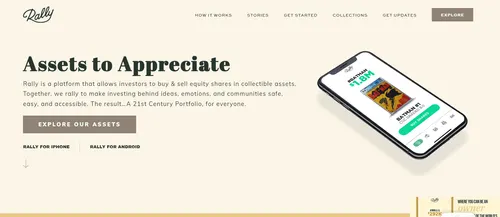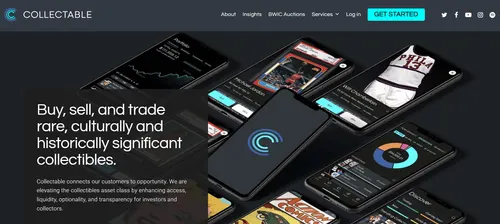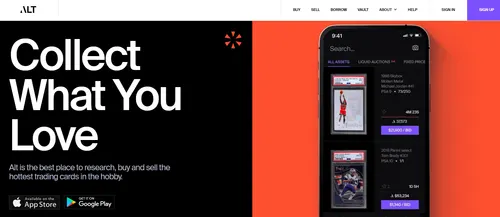Our partner, XM, lets you access a free demo account to apply your knowledge.
No hidden costs, no tricks.

Alternative investments have become more and more popular over the years. Due to their low correlation with the traditional financial markets of stocks and bonds, investors are actively considering placing a portion of their portfolios in assets like farmland, wine, watches, artworks, collectibles, etc.
Collectibles, in particular, have been growing in popularity, due to the diverse nature of items that can be considered collectible and the gradual gain in market value due to extreme scarcity.
Collectibles can come in many forms and range from vintage items, such as clothing and accessories, to vehicles and playing cards.
The gray area surrounding the definition of what a collectible entails means that the market can become saturated and expert evaluations are often required in order to assess the market value of a particular item.
For many years, investors could only invest in collectibles by paying a hefty fee and physically acquiring the item. However, with the advent of digital technology and the democratization of finance, some platforms offer fractional ownership of any given collectible item, which is vetted carefully by seasoned professionals to derive a fair market value.
If you are curious about investing in collectibles and don’t know where to start - this investfox article is for you.
A collectible can be any item that carries a significant inherent value due to its scarcity. It is a regular occurrence to see a collectible being made out of something that has a limited release, such as a vinyl record, a special edition vehicle, a piece of designer clothing, etc.
These items carry a certain degree of prestige and status, which is attractive for investors, as they assume that due to their scarce nature, these items will only keep increasing in value as the years go by.
Some common collectible items you can invest in include:
This is not an exhaustive list of potential collectibles that can be bought and sold on the market, as the list can contain items from an extremely broad range of categories.
Before diving into the sophisticated platforms for collectibles investing, it is important to consider that collectibles can be bought and sold on a personal basis and may not require intermediaries to facilitate the trade. Certain collectibles with a lower market value are often bought and sold via traditional commerce platforms, such as eBay and Etsy, while others that carry a significant amount of value are often bought and sold via auction houses.
These items may be particularly valuable and sell for hundreds of millions of dollars each. This is especially true for one-of-a-kind artworks and vintage vehicles and watches, but may also apply to other categories as well.
For items that are more on the expensive side, users can check out 1stDibs.com (NASDAQ:DIBS), which is an online marketplace that offers a broad range of collectibles and luxury items for sale, including watches, clothing, furniture, jewelry, etc.
Certain investment platforms have built their business models around buying collectible items and dividing them into shares, which are then sold to the public as LLCs that hold these items on their behalf for a certain period of time. Once the platform evaluates the items and decides to sell them, the proceeds are then distributed among shareholders.
Such a business model allows for a more diverse group of investors to gain access to these investments and make the luxury industry more accessible via a liquid secondary market.

Rally Rd is a collectible investment platform that allows investors to acquire shares in classic cars, luxury watches, comic books, NFTs, sports memorabilia, fine spirits, rare literature, vintage video games, and so on.
The platform manages over $15 million in clients' assets and also offers a secondary trading platform for shareholders - increasing liquidity.
A notable investment made on the platform includes the sale of the 1985 Super Mario Bros copy on the NES, which was purchased for $150,000 in 2020 and sold for over $2 million after a year.
Rally stands out by its sheer selection of collectible investment products, which also include dinosaur bones.
The selection and investment process, as described by the company on its website, is as follows:
The Rally secondary market gives investors added liquidity to sell their investments more easily.

Collectable is a platform that was established in 2020 and offers mostly sports memorabilia and trading cards for investments and manages over $50 million in investor funds.
Collectable offers different methods of investing on its platform - from online auctions to fractional share ownership.
The BWIC auctions on Collectable offer some major advantages to investors, such as:
Once an asset is accepted as a consignment into the BWIC auction, the bidders can each submit 1 discreet, non-cancellable bid during the 7-day qualifying round.
The top 3 bids in the qualifying round advance to the extended bidding round, where the top 3 bidders can submit 1 non-cancellable bid.
Trading cards and sports memorabilia are characterized by rapid appreciation in price, which is highly advantageous for investors.

Goldin is a relatively older investment platform that was launched in 2012 and has amassed over $500 million in assets under management. The platform allows investors to put their capital into pop culture memorabilia, comic books, and sports cards.
Goldin offers a few distinct services to its customers, such as:
Goldin offers two types of auctions - Weekly and Elite. Weekly auctions start from $100 in estimated value and a starting bid price of $5. Extended bidding lasts 15 minutes and is open for 9 days.
Elite auctions start from $7,500 in estimated value and a starting bid price of $500. Extended bidding lasts 30 minutes and is open for 17 days at a time.

Alt is a card investment platform launched in 2021 and offers a wide variety of sports cards. The platform offers a storage service and a secondary market for investors to easily buy and sell their cards.
Some of Alt’s features include:
The price data on Alt is updated in real-time and users can frequently review the going market prices of their collections.

Otis offers a wide range of collectibles for investment assets, such as sneakers, sports cards, jerseys, vintage books, NFTs, etc.
Investors can buy and sell shares of collectibles and art pieces - each of which is divided into shares. Investors can manage their portfolios and be informed about the latest pricing changes and news.
Users can trade in real-time with just a few clicks or taps on the phone screen by selecting the number of shares to buy/sell.
Otis also hosts pop-ups where users can see the assets physically at the dedicated gallery space in New York City.
Another feature offered by Otis is the Otis Magazine, which presents curated articles from the world of collectibles, including major auctions, new limited releases, etc. Otis is a subsidiary of the popular social trading stock brokerage Public, which has integrated its services.

Masterworks is an online platform that allows users to invest in shares of fine art. The platform includes works from world-famous artists, such as Banksy, Andy Warhol, etc.
Masterworks buys the artworks from private collections and auctions, forms an LLC that holds these assets, divides them into shares, and sells them to its users.
Masterworks identifies some of the most sought-after pieces to offer its users to make sure that the value of these pieces increases considerably in the future.
Masterworks claims to offer higher returns than the classic diversified portfolios of stocks and bonds, as well as major indices, such as the S&P 500.
Direct ownership of collectibles requires a certain amount of knowledge and expertise on behalf of investors, as these collectibles are often quite old and fragile and require considerable upkeep and maintenance, which can be expensive.
For example, an artwork needs to be protected from the elements to preserve the paint and color in optimal condition. If not, the collectible will lose value and the entire investment could be rendered useless.
Investing in collectibles places all of this burden on the investment platform, which often employs the services of professional curators who can take care of the collectibles, and the platform charges fees for these services. Investment platforms also give users considerably more liquidity and convenience, as well as the opportunity to make particle investments.
However, this does not mean that platforms are clearly superior. Certain investors prefer having tangible assets at their disposal where they can oversee the maintenance and safety of their possessions themselves - giving them much more autonomy over the process.
Investing in collectibles may not be for everyone and it is important to consider the inherent risk and rewards associated with investing in such alternative assets.
Our partner, XM, lets you access a free demo account to apply your knowledge.
No hidden costs, no tricks.
Investing in collectibles means buying items that hold an espoused value that increases over time due to scarcity. Collectibles may include clothing, cars, watches, antiques, trading cards, etc., and are often sold via auction.
Most collectibles are highly illiquid and require extensive knowledge and time in order to facilitate transactions, which are typically done via auction houses.
Conversely, alternative investment platforms offer investors the opportunity to own a fraction of collectibles while the platform curates a secondary market for them to trade shares in their possession.
Some collectibles can greatly increase in value and reap great returns. However, this is almost never a guarantee and the value of collectibles depends on the authenticity, scarcity, and demand for these items.